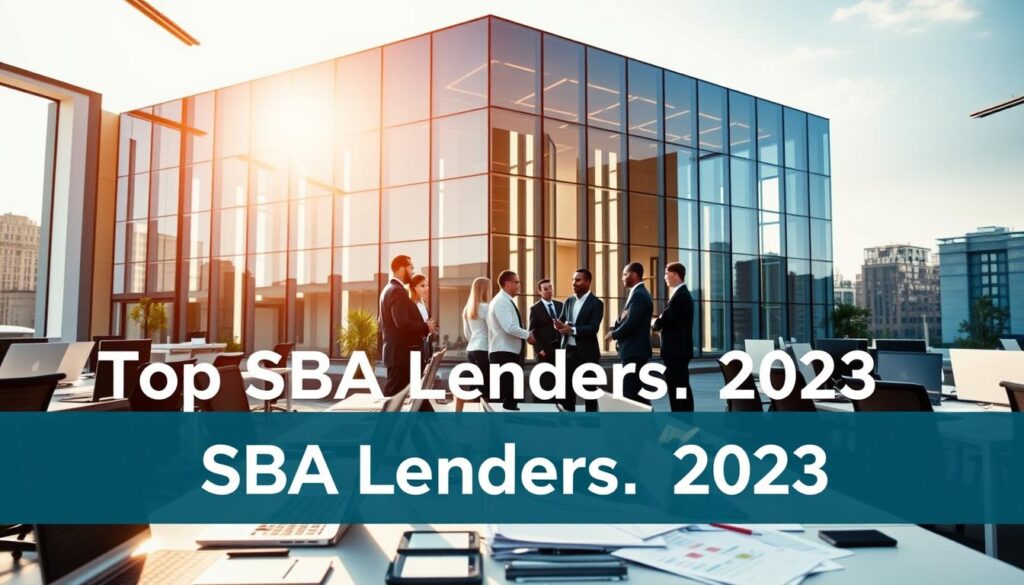Get the Funding Your Small Business Needs with SBA Loans Are you having trouble getting the money your business needs to grow or bounce back? You’re not alone. Many small business owners find it hard to get capital, but there’s a way to help.
SBA loans are a good option, backed by the U.S. Small Business Administration and given out by certain lenders. They offer flexible terms and low interest rates. This makes them a great choice for businesses needing money for different reasons.
Looking to start-up, grow, or get back after a disaster? SBA loans can unlock your business’s full potential.
Key Takeaways
- Flexible terms and low interest rates
- Partially guaranteed by the U.S. Small Business Administration
- Issued by participating lenders, usually banks
- Viable financing option for various business needs
- Helps small businesses access capital
What Small Business Owners Need to Know About SBA Financing
To understand SBA financing, knowing the SBA’s role and how SBA-backed loans work is key. The Small Business Administration (SBA) is a government agency that supports small businesses. It offers resources, guidance, and financing options.
The Role of the Small Business Administration
The SBA helps small businesses by setting loan guidelines and reducing lender risk. This makes it easier for small businesses to get the capital they need. The SBA guarantees a part of the loan, which lowers the risk for lenders.
The Role of the Small Business Administration
The SBA does more than just set loan guidelines. It also provides resources and support to small businesses. For example, it offers counseling and training programs to help them succeed.
How SBA-Backed Loans Work
SBA-backed loans help small businesses get the funding they need. Businesses can use the Lender Match tool to find SBA-approved lenders. The SBA guarantees a part of the loan, which makes it easier for lenders to offer better terms.
Understanding SBA-backed loans and the SBA’s role helps small business owners make better financing choices. With the SBA’s support, small businesses can grow, create jobs, and contribute to the economy.
SBA Loans for Small Business: Key Advantages
SBA loans offer many benefits for small businesses. They can make a big difference. Knowing these advantages helps you choose the best financing option.
Lower Down Payments Than Traditional Financing
SBA loans require less down payment than traditional loans. This makes it easier for small businesses to get the funding they need. For example, an SBA 7(a) loan might need only 10% to 20% down. Traditional loans often ask for 20% to 30% or more.
Extended Repayment Terms
SBA loans also have longer repayment terms. This helps small businesses manage their cash flow better. With longer terms, businesses can pay less each month. This frees up more money for their operations. For instance, SBA loans can last up to 25 years for real estate or 10 years for equipment.
Competitive Interest Rates
SBA loans have competitive interest rates. These rates are often as good as or better than traditional loans. This can save small businesses a lot of money over time. According to SBA loan information, SBA-guaranteed loans have rates and fees similar to non-guaranteed loans.
Business Development Resources and Support
SBA loans also provide access to business development resources. The SBA offers counseling, training, and contracting opportunities. These resources help small businesses succeed and gain a competitive edge.
| Loan Type | Down Payment | Repayment Term | Interest Rate |
|---|---|---|---|
| SBA 7(a) Loan | 10% to 20% | Up to 10 years | Competitive rates |
| SBA 504 Loan | 10% to 20% | Up to 25 years | Competitive rates |
Exploring Different SBA Loan Programs
As a small business owner, knowing about SBA loan programs is key. The Small Business Administration (SBA) has many loan options. They help small businesses at different stages and in various industries.
7(a) Loan Program: The Most Popular Option
The 7(a) loan program is the SBA’s top choice. It helps with working capital, equipment, and buying businesses. Loans can go up to $5 million, making it flexible for many needs.
CDC/504 Loan Program for Major Assets
The CDC/504 loan is for big purchases like real estate and equipment. It offers long-term, fixed-rate loans up to $5.5 million for big projects.
Microloans for Smaller Funding Needs
The SBA’s microloan program is for smaller needs. It offers loans up to $50,000 for starting or growing businesses. It’s perfect for those needing less capital.
Disaster Loans and Emergency Funding
The SBA’s disaster loan program helps after disasters. It offers low-interest loans for repairs or replacements. This helps businesses recover from damage.
Understanding SBA loan programs helps small business owners make better choices. They can pick the best option for their needs.
Meeting SBA Loan Requirements: Qualification Checklist
Small business owners need to know the SBA loan qualifications to get funding. The SBA has specific rules for who can get a loan. These rules include several important factors.
Business Size Standards by Industry
The SBA says what makes a business small based on its industry and size. For example, a small retail business usually has less than $7 million in sales. Your business must fit these size standards to qualify.
Credit Score and Financial History Requirements
A good credit score and financial history are key for SBA loans. Lenders want a score of 620 to 650, sometimes higher. They also check your business’s money flow and profits.
Time in Business Considerations
The SBA usually wants businesses to be at least two years old. But, some loans have easier rules. The longer your business runs, the better its financial record and the more likely it is to get an SBA loan.
Collateral and Personal Guarantee Expectations
For SBA loans, especially big ones, you might need to offer collateral. You might also have to give a personal guarantee. This means you could be personally responsible for the loan if your business can’t pay.
By looking at these key points, small business owners can see if they qualify for SBA loans. Meeting these requirements is the first step to getting the funding your business needs to grow.
How to Apply for SBA Loan: A Comprehensive Guide
To apply for an SBA loan, knowing what’s needed is key. The process has several important steps. These steps can help you succeed.
Essential Documentation Checklist
First, gather all needed documents. This includes business and personal tax returns, financial statements, and business licenses. Having everything ready makes the application smoother.
Some important documents for an SBA loan are:
- Business tax returns for the last three years
- Personal tax returns for the last three years
- Financial statements, like balance sheets and profit/loss statements
- Business licenses and registrations
Creating a Strong Business Plan
A good business plan is crucial for getting an SBA loan. It should cover your business goals, target market, financial outlook, and management team. A solid plan shows lenders you have a clear plan for success.
Make sure your business plan includes:
- A detailed market analysis
- Financial projections, like income statements and cash flow statements
- A clear management structure
Finding and Approaching SBA-Approved Lenders
Not all lenders are the same for SBA loans. Look for lenders approved by the SBA and experienced with SBA loans. Start by researching top national banks, regional banks, and credit unions with SBA loan programs.
When you talk to lenders, be ready with your business plan, financial documents, and other important info. This helps lenders understand your financial situation and make a decision.
The Application Timeline: What to Expect
The SBA loan application process can take weeks to months. Be patient and prepared. Knowing what to expect helps you navigate the timeline and increase your chances of success.
Several things can affect the timeline, such as:
- The complexity of your loan application
- The lender’s processing time
- The SBA’s review and approval process
The Best SBA Lenders of 2023
Finding the right SBA lender can be tough. But, I’ve made a list of the top SBA lenders for 2023. These lenders help you get the funding you need for your business. Choosing the right one is key for a smooth application process.
The best SBA lenders offer great rates, flexible terms, and top-notch service. In 2023, you have many options. You can choose from national banks, regional banks, credit unions, and online lenders.
Top National Banks for SBA Financing
National banks are a top choice for SBA loans. They have a wide range of loan products and lots of experience. They also offer competitive interest rates, helping small businesses grow.
Regional Banks and Credit Unions with Strong SBA Programs
Regional banks and credit unions are also great for SBA loans. They provide personalized service and know the local market well. They might offer flexible terms and quick processing, which is good for small businesses.

Online and Alternative SBA Lenders
Online and alternative lenders are gaining popularity. They offer quick access to SBA loans. They have more flexible credit score requirements and faster application times, helping businesses that traditional banks might not serve.
When picking an SBA lender, look at interest rates, fees, and repayment terms. Research and compare different lenders to find the best SBA loan for your business in 2023.
Understanding Current SBA Loan Rates and Terms
Exploring SBA loan rates and terms is key for smart decisions. The Small Business Administration (SBA) offers great financing for small businesses. But, the details can be tricky.
Base Rate Structures (Prime Rate + Margin)
SBA loan rates are based on the prime rate plus a margin. The prime rate is what top customers pay. The margin changes based on the loan and the borrower’s credit.
Interest Rate Ranges by Program Type
Each SBA loan program has its own rate range. For example, the 7(a) loan program has rates from 6% to 8.5%. This depends on the loan size and term. Other programs, like the CDC/504, have different rates.
| Loan Program | Interest Rate Range | Typical Repayment Term |
|---|---|---|
| 7(a) Loan | 6% – 8.5% | 7-25 years |
| CDC/504 Loan | 5.5% – 7.5% | 10-20 years |
| Microloan | 8% – 13.75% | 6 years |
Fee Structures and Additional Costs
SBA loans also have fees like an upfront guarantee fee and a yearly service fee. These fees change based on the loan program and amount. For example, the 7(a) loan program’s guarantee fee is 2% to 3.5% of the guaranteed loan amount.
Typical Repayment Terms by Loan Type
Repayment terms for SBA loans differ by type. Working capital loans usually last 5 to 7 years. Real estate loans can go up to 25 years. Knowing these terms helps manage cash flow and repay loans on time.
Why SBA Loan Applications Get Rejected (and How to Avoid It)
Applying for an SBA loan can be tricky. Knowing the common mistakes can help you get approved. As a small business owner, it’s key to know why SBA loans are often denied. This way, you can steer clear of these errors.
Insufficient Credit History or Low Scores
Low credit scores or no credit history are big reasons for SBA loan denials. Lenders check your credit to see if you’re a good risk. A bad score means you’re riskier, making it harder to get a loan. To fix this, keep your credit good by paying on time and using less of your credit limit.
Inadequate Collateral or Cash Flow
Not having enough collateral or cash flow is another common issue. Lenders need collateral to protect their investment and want to see they can pay back the loan. To boost your chances, offer good collateral and show steady cash flow.

Incomplete or Inaccurate Documentation
Missing or wrong documents can also stop your SBA loan. Lenders need certain papers to review your application. Make sure you have everything and double-check your info to avoid delays or denials.
Industry Restrictions and Ineligible Businesses
Some businesses can’t get SBA loans because of their industry or structure. It’s important to know if you fit the bill before applying.
| Reasons for SBA Loan Rejection | How to Avoid |
|---|---|
| Insufficient Credit History or Low Scores | Maintain a good credit history, make timely payments, and keep credit utilization low. |
| Inadequate Collateral or Cash Flow | Provide sufficient collateral and demonstrate a stable cash flow. |
| Incomplete or Inaccurate Documentation | Provide all required documents and ensure accuracy. |
| Industry Restrictions and Ineligible Businesses | Understand eligibility criteria and industry restrictions. |
By knowing why SBA loans get rejected and how to avoid these issues, small businesses can better their chances. This way, you can get the funding you need to grow and thrive.
Alternative Small Business Financing Options
Small businesses have more than just SBA loans to choose from. These options can help with growth, expansion, or recovery.
As a small business owner, you might know about other financing options. Traditional bank loans and lines of credit are common. They need a good credit score and collateral but offer stable funding.
Traditional Bank Loans and Lines of Credit
For businesses with good credit, bank loans and lines of credit are good choices. They have competitive rates and flexible terms. To get them, you need to show steady income and collateral.
Online Lenders and Fintech Solutions
Online lenders and fintech solutions are also popular. They’re quick and have easier credit rules. But, they might have higher rates and fees.
Crowdfunding and Peer-to-Peer Lending
Crowdfunding and peer-to-peer lending platforms are another option. They let businesses raise money from many people. But, they can be riskier and cost more.
Angel Investors and Venture Capital
For businesses looking to grow fast, angel investors and venture capital are good. They give money for equity. This is great for startups but means you lose some control.
In summary, small businesses have many financing options besides SBA loans. Knowing the good and bad of each helps make the right choice.
Real Success Stories: Small Businesses Transformed by SBA Funding
Small businesses have seen great success thanks to SBA funding. The Small Business Administration (SBA) helps entrepreneurs and small business owners. It gives them the money they need to start, grow, and recover their businesses.
Startup Launch Success Stories
Many startups have gotten SBA loans to make their ideas real. For example, a tech startup in California got a loan to develop its product and hire staff. Thanks to the SBA, this startup overcame early hurdles and grew fast.
In New York, a restaurant used an SBA loan for startup costs like equipment and staff. The loan helped it build a loyal customer base and grow.
Business Expansion and Growth Examples
SBA loans have helped businesses grow and enter new markets. A manufacturing company in the Midwest used a loan for new equipment and technology. This increased its production and created jobs.
A retail business in Texas got a loan to expand its store and hire more staff. The loan boosted its revenue and made it a top retailer locally.
Disaster Recovery and Resilience Cases
The SBA has helped businesses hit by disasters recover and rebuild. For example, a Florida business got a disaster loan after a hurricane. This allowed it to fix damage and keep employees working.
In Louisiana, a business used an SBA disaster loan to bounce back from a flood. It rebuilt and regained its customer base.
Minority and Women-Owned Business Achievements
The SBA has also helped minority and women-owned businesses. For instance, a minority-owned business in Illinois got a loan to grow and create jobs. It boosted the local economy.
A women-owned business in California launched with an SBA loan. It developed its product and established a strong market presence.
| Industry | Business Type | SBA Loan Use |
|---|---|---|
| Technology | Startup | Product development and staffing |
| Retail | Expansion | Store expansion and staffing |
| Manufacturing | Expansion | Equipment and technology investment |
| Restaurant | Startup | Initial costs, including equipment and staffing |
These stories show how SBA loans have helped small businesses in the U.S. The SBA’s funding has allowed businesses to start, grow, recover, and succeed. This creates jobs and boosts local economies.
Conclusion: Is an SBA Loan Right for Your Small Business?
SBA loans can be a big help for small businesses. They offer funding from $500 to $5.5 million. This can help businesses grow, expand, or cover daily costs.
Before getting an SBA loan, check if you qualify. Learn about SBA loan requirements and how to apply. This is key to getting the funding your business needs.
SBA loans have many benefits. They have lower down payments, longer repayment terms, and good interest rates. By looking at your business’s needs and finances, you can see if an SBA loan is right. With the right help and understanding of the application, you can use SBA financing to grow your business.
FAQ
What is an SBA loan, and how does it work?
An SBA loan is backed by the Small Business Administration. This makes it easier for small businesses to get money. The SBA works with lenders to help small businesses get the funds they need.
What are the benefits of SBA loans for small businesses?
SBA loans have many benefits. They offer lower down payments and longer repayment terms. They also have competitive interest rates and resources for business growth. These make SBA loans a good choice for small businesses.
What are the different types of SBA loan programs available?
The SBA has several loan programs. These include the 7(a) Loan Program, CDC/504 Loan Program, Microloans, and Disaster Loans. Each program helps with different business needs, like starting up, growing, or recovering from disasters.
What are the eligibility requirements for SBA loans?
To get an SBA loan, businesses must meet certain criteria. They need to be the right size, have good credit, and be in business for a while. They also need to show they can repay the loan and have collateral.
How do I apply for an SBA loan?
To apply for an SBA loan, you need to prepare important documents and have a solid business plan. You also need to find a lender approved by the SBA. The process involves filling out a loan application, providing financial information, and waiting for the lender’s decision.
What are the current SBA loan rates and terms?
SBA loan rates and terms vary. They depend on the loan program and the lender. Interest rates are usually the prime rate plus a margin. Repayment terms can be several years or even decades. There may also be fees and other costs.
Why do SBA loan applications get rejected?
SBA loan applications can be rejected for several reasons. These include bad credit, not enough collateral, wrong documentation, or being in a restricted industry. To improve your chances, address these issues and work with an experienced lender.
What are the alternative financing options for small businesses?
Small businesses have other financing options besides SBA loans. These include bank loans, online lenders, crowdfunding, and equity investments. Each option has its own advantages and disadvantages. Businesses should think carefully about their needs before choosing.
Can SBA loans be used for any business purpose?
SBA loans can be used for many business needs. This includes starting up, growing, buying equipment, or recovering from disasters. But, the loan must be for a real business purpose and the business must be able to repay it.








